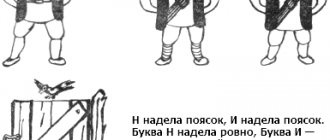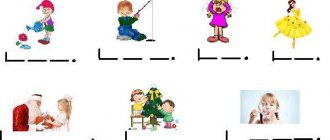Phonetics terms and groups
Science has come far in the study of the Russian language. Special emphasis was placed on the section of phonetics - the study of the written representation of sounds. Experts collected statistics on the sonority of human language:
- On average, a person produces a couple of hundred sounds in one day.
- They use more than 50 sounds to express their thoughts.
- However, only 33 of their designations are used in the letter.
The two main tools of phonetics are letters and sounds . It is important to know the features of each group and their differences:
- An element that is used only for written display and reading is a letter.
- An element that is only spoken and listened to is sound.
The difficulty of parsing is that the pronunciation of a word can differ significantly from its spelling. For example, the number of one of the groups of elements (letters or sounds) may be more/less than another. Otherwise, the quantity may remain the same, but the written display will not match the audible one. This is due to the rules of spelling and spelling.
However, phonetics only includes aspects of pronunciation . These include:
- sound;
- letter;
- accent;
- syllable.
All of the above terms have individual properties, but together they form a characteristic of the sound of a word - phonetic analysis.
Features of parsing
The most common situation in which mistakes are made is when the sound and the written symbol do not match each other. If spelling is responsible for the correct spelling, then phonetics regulates the rules of pronunciation of words. To successfully complete audio analysis, it is recommended to consider a few tips:
- Accurately establish all the features of the sound of a word.
- Make your own transcription for each letter.
- Under no circumstances should sounds and letters be adjusted to match each other. For example, shi [shi] - cars.
- After completion, pronounce the word out loud clearly and carefully again, checking each unit of speech.
There is a special algorithm for phonetic parsing. Some information is required to be memorized, the rest is recommended to be written down in the form of a memo. The main rules in phonetic analysis within the school curriculum:
- Voiced consonants at the end of a word become voiceless. For example, oak [p].
- Hard consonants become soft if they are followed by soft consonants. For example, here [z'd'es']. This mainly happens with the letters: z/s, d/t, n.
- Voiced consonants become voiceless if they are followed by a voiceless consonant. For example, rarely [p 'etk a].
- Deaf people are transformed into voiced ones if they stand in front of the same voiced ones. For example, pass [zdat '] sample.
For students of higher educational institutions with a philological profile, the rules are somewhat larger. They additionally study:
- accommodation;
- dissimilation;
- reduction.
These three points are studied for a deeper understanding of phonetics and how speech norms are transformed. They will also help students who want to teach in the future to explain complex topics more clearly and quickly and analyze common mistakes of their students.
Sound-letter analysis of words in 1st grade, presentation for lesson (1st grade) on the topic
Slide 1
Sound-letter analysis of words in first grade
Slide 2
Symbols used to perform sound-letter analysis of words - vowel sound - soft consonant sound - hard consonant sound - voiceless consonant sound - voiced consonant sound - softens the sound - transition to soften the sound - deafening a voiced consonant sound
Slide 3
Sound-letter analysis of words is carried out from the first lessons of section II of the “Primer” “Learning letters - learning to read” (authors - R.N. Buneev, E.V. Buneeva, O.V. Pronina).
Slide 5
e yu i yo i e yu yo
Slide 6
Sound-letter analysis of words in first grade. Algorithm for performing sound-letter analysis of words. Sound-letter analysis of the word giri. 1. We divide the word into syllables: g and r and 2. In the first syllable we find a vowel letter, and a butterfly sits on the letter. She flies to the letter g and softens it: g i. 3. The same work takes place in the second syllable. 4. Then we analyze the sounds according to their voicedness and deafness: we “put hats” on them. The work looks like this: g and r and 5. This word has 4 letters, 4 sounds.
Slide 7
For comparison, let's take the word shooting gallery. The butterfly “sits” on the letter, softens the letter t, but does not fly back. Therefore, the sound p remains solid. t and r Sound-letter analysis of the word rapier: Divide the word into syllables: r a p i r a Find the stress: r a p i r a The first syllable is ra, the vowel letter is a, there is no softening, which means the sound r is hard. We denote it in blue. The second syllable is pi. The vowel sound i, it serves to indicate the softness of the sound p: a butterfly sits on it. The butterfly “saw” the letter p, denoting a consonant sound, and flew over to it. The sound [n '] is soft, denoted in green. The third syllable is like the first. We designate consonant sounds by voicedness and deafness. It looks like this: r a p i r a 7. The word rapier has 6 letters, 6 sounds.
Slide 8
Sound-letter analysis of the word: column. 1. Divide the word into syllables: Column 2. Find the stress in the word: Column 3. In the first syllable, the unstressed vowel is indicated by the letter o: Column 4. Double consonants denote one sound: column 5. There are no vowels in this word to indicate the softness of the consonants, so we don’t draw a butterfly anywhere. 6. We designate sounds by the hardness and softness of consonants, we designate them with circles. co l o n a [ ] a [ ]
Slide 9
Sound-letter analysis of the word fruit. 1. The word has one syllable, we do not put stress. 2. The vowel sound o. 3. Consonant sounds are all hard. 4. At the end of the word there is a deafening: p o d [t] 5. “We put on” hats: p o d [t] Although there is a letter D at the end of the word, we “put on” a hat - a cylinder, because on at the end of the word the sound [t] is heard.
Slide 10
During the lesson, children write words in block letters and draw the corresponding signs with colored pens. Children really like this kind of work. They enjoy putting hats on the letters, thereby memorizing voiced and voiceless consonants well. There are almost no mistakes made at work. Linden
Slide 11
column [a]
Slide 12
guitar
Slide 13
machines [s]
Classification of sounds
In turn, sounds are also sorted into two groups. Their main difference from each other is the anatomy of formation. What classes exist:
- Consonants. When pronouncing them, a person faces obstacles. The barrier is one organ or a whole group of them (lips, teeth or tongue).
- Vowels. With the help of the larynx and individual parts of the oral cavity, air leaves the lungs without any interference - this is how a vowel sound is formed.
To understand the remaining differences, it is necessary to analyze each concept in detail.
Types of vowels
In total, there are 6 vowel sounds in the Russian language (o, i, a, e, ы, u), but up to 10 letters are used to denote them in writing. This is due to the fact that some of the vowels can have several letter designations at the same time. For example, there is a semivowel “th”. It is worth considering that in the school curriculum it will be indicated by a consonant sound. Also, its purpose is to display additional vowels (I, e/e, yu). In phonetic analysis it will look like:
- I - [ya];
- e - [ye];
- yu - [yu];
- ё - [yo].
However, these vowels will not always appear as two letter elements in the diagram. The rule holds only in certain conditions:
- At the beginning of the word. (Yana, January).
- After vowel sounds (safe haven, young mother, high-speed train).
- After the hard/soft sign (enter the house).
Otherwise, these vowels will soften, but they will not give a double sound together with “y” (guys, wind).
All vowels are further divided into two subgroups, depending on the sound in front of them. These include:
- If there is a hard consonant (cup, forty). This group includes: a/o, u, e, s.
- If a soft consonant is indicated in front (saw, feather). These include: i, e/e, i/e.
Each vowel also has its own personal characteristic - stress. It must be indicated in the phonetic analysis. According to this feature, a vowel can be either stressed or unstressed. The stressed sound is always written and pronounced the same way (Moscow - under the accent “a”).
Consonant clusters
There are significantly more consonant sounds than vowels. There are 20 of them in total. They are also divided into groups according to certain characteristics. In this case, consonants can simultaneously appear in several groups, that is, have several characteristics:
- Voiced: b, v, d, d, g, z, r, l, n, m.
- Voiceless: p, f, k, t, sh, s, x, c, h, shch.
- Pairs: b/p, h/f, g/c, d/t, w/w, s/s.
- Unpaired, but they are divided into 2 more subgroups. Voiced: r, l, n, m. Voiceless: x, c, ch, shch.
- Hissing: zh, h, sh, shch. All others can be classified as soft or hard.
- Hard: f, w, c. Their softness does not change in any situation.
- Also unchanged soft: th, ch, shch.
During pronunciation, problems may arise with the correct determination of voicedness, since both deaf and voiced have the same articulation (cactus). There are two methods for solving the paired consonant problem:
- Divide the alphabet into two parts. The voiced consonants will come first, followed by the voiceless ones.
- Study the rules for the positions of consonants, at which they necessarily become voiced/voiceless.
What is sound analysis of a word? Printed consultation for parents.
Olga Gordeeva
What is sound analysis of a word? Printed consultation for parents.
WHAT IS SOUND WORD ANALYSIS ?
Sound analysis of a word is the determination of the sounds in a word in order and their characteristics (vowel - consonant, voiced - voiceless, soft hard)
The sound pattern of a word is a sequence of squares - symbols, laid out in the same order as the sounds in the word .
HOW TO PERFORM A SOUND WORD ANALYSIS WITH A CHILD ?
Sound analysis is performed by sequentially highlighting the sounds in a word and their characteristics with the .
Let's do a sound analysis of the word HOME :
1. Let’s highlight the first sound :
ddd-om - the first sound D - it is consonant , voiced, hard - let's denote it with a blue square with a bell.
2. Let’s highlight the second sound :
d - ooo - m - second sound O - he
vowel - let's denote it with a red square.
3. Let’s highlight the third sound :
to - mmm - the third sound M - it is consonant , voiced, hard - let's designate it with a blue square with a bell.
The word HOUSE has 3 sounds , 2 consonants and 1 vowel.
Consonant sounds D and M.
Vowel sound O.
Let's name the sounds in order : D O M.
Let's write the word in letters : HOUSE
SOUND ANALYSIS OF THE WORD WHALE
1. Let’s highlight the first sound :
кькь – it – the first sound Кь – consonant , unvoiced, soft, denoted by a green square.
2. Let’s highlight the second sound with our voice – kiiiit , the second sound I , Let’s denote it with a red square.
3. Let’s highlight the third sound with our voice – kittt , the third sound T , it is consonant, voiceless and hard, we’ll designate it with a blue square.
The word whale has 3 sounds : 2 consonants and 1 vowel. Consonants Кь and Т. Vowel I. Let's name the sounds in order Кь , И, Т.
TIP FOR PARENTS .
Letters denoting voiced sounds :
M, B, G, D, N, V, F, L, R, Z, J.
Letters denoting unvoiced sounds :
P, K, X, T, F, Sh, S, Ch, Shch, C.
Children determine whether a sound is voiced or unvoiced your throat rings while pronouncing a sound
-
sonorous sound . If it doesn’t ring
, he’s deaf
Letters that always denote hard sounds : Ш, Ж, Ц.
Letters that always denote soft sounds : Shch, Ch, Y.
The remaining letters can represent two sounds: hard and soft : T and T', P and P', K and K', D and D', etc.
Softness and hardness of sounds children
determine by ear:
MEL - the sound is soft .
CHALK - the sound l is hard .
CAT – the sound K is hard .
KIT - the sound K is soft .
Parents can check as follows:
If in a letter A, O, U, Y, E are written after a consonant, then it means a hard sound .
If the letters E, E, Yu, I are written after a consonant letter in a letter, then it means a soft sound .
sounds E , Ё, Yu, I; these are vowel letters that indicate the softness of a consonant in writing.
Voiced consonant sounds at the end of words in speech are deafened and replaced by paired unvoiced ones: D - T, G - K, B - P, Zh - Sh, V - F, Z - S.
We write ICE - we say [FLIGHT]
We write KNIFE - we say [NOSH]
We write SNOW - we say [SNACK]
The letters E, E, Yu, I, standing in a word after a consonant, indicate the sounds E , O, U, A,
All this must be taken into account when performing sound analysis of a word .
Schematic model
During phonetic analysis, a schematic representation of the word is compiled. In fact, this is a diagram in the form of color cards of different shapes. Sound analysis of a word and diagram for preschoolers is an example that helps create an image for perceiving and understanding the details of the structure of a word. There are only two shapes - rectangular or square. But there are many color differences:
- The square blue card is a hard consonant.
- A green card in the shape of a square is a soft consonant sound.
- A square in red is a vowel sound.
- Two triangles (blue and red) connected into one rectangle - a syllable consisting of a hard consonant and a vowel.
- A red and green triangle, which are connected into 1 rectangle - a syllable consisting of a soft consonant and vowel sounds.
The sound patterns of words in grade 1 (cards) have their exact sequence in color and shape. If you use this method correctly, learning will be quick and easy.
They use sound analysis of words in 1st grade (diagrams and analysis) and preschool education, as an auxiliary tool in teaching reading. The teacher will not only be able to talk about each unit of speech separately, but will teach how to put them together and separate them again. In addition, the model highlights the difference in pronunciation between consonants and vowels.
Phonetic parsing algorithm
When all the terms have been studied, the speech units have been sorted into groups, you can proceed directly to the phonetic analysis itself. All analysis results must be recorded. In appearance, it is similar to compiling a transcription when reading and pronouncing words from foreign languages.
To carry out the analysis correctly, you need to follow the algorithm. Procedure:
- Write down the selected word according to spelling rules.
- Select the main parts - syllables. For example, the alphabet is az-bu-ka.
- Determine which vowel is stressed. Ski - stressed sound "s".
- Make a diagram (transcription) of sounds. Play - [play'].
- Display a count of the number of letters and sounds in a word. Elena - 5 letters, 6 sounds.
The analysis can be written not only point by point, but also in the form of a column. In this case, each letter is written on a separate line and given its own characteristics.
Division into syllables
One of the parsing points is to divide the word into syllables. Syllables are the smallest unit of speech structure. There is a little trick: “to count the number of syllables in a word, you can simply count the vowel sounds.” For example, the word “aster” has only 1 syllable.
However, division is still subject to strict rules, which are not always consistent with the requirements of word hyphenation.
Initially, it is important to know that syllables have several varieties:
- Open - if it ends with a vowel sound.
- Closed - if there is a consonant at the end (notebook).
- Covered if there is a consonant sound at the beginning (sour). Therefore, if the vowel is open (window).
In addition to types, there are other parsing rules. What you need to know about syllables:
- A syllable must contain one vowel and one consonant sound. For example, rose (ro-za). Moreover, individual even important parts cannot be full-fledged syllables. For example, a prefix is not a syllable.
- In general, syllables begin with a consonant and must be followed by a vowel. A consonant sound by itself cannot form a syllable. For example, the word world has one syllable, not two.
- If a word has a soft/hard sign, it is part of the previous syllable. For example, driveway. In addition, a hard/soft sign cannot be a separate syllable. For example, seven is 1 syllable, boy is 2 syllables.
- Several letters that create one sound cannot be divided into different syllables. For example, spinning - spinning.
Like any other science, phonetics is constantly evolving. Therefore, the rules of phonetic parsing may change over time. Latest changes to the analysis:
- According to the old rules, double letters in a word were distributed over different syllables. Today it is customary to write them in the syllable that they begin. For example, cool.
- According to innovations, voiceless consonants are written in the syllable following them (dot: dot-chka). At this time, the voiced ones remain in the preceding syllable (strawberry: club-ni-ka).
Knowledge of phonetics not only gives spelling literacy. This science promotes the development of memory and phonetic hearing, teaches how to correctly and beautifully pronounce certain sounds, understanding the details of their composition. And if you can’t do the analysis yourself, you can do an audio analysis of the word online.
Basic concepts: phonetics, letter, sound
Phonetics is the branch of language science that deals with the study of speech sounds.
The letters are their graphic interpretation. Thanks to these symbols, sound information is transferred to paper when writing.
People make about a hundred different sounds, but only use about half of them when communicating with each other. And when writing, sounds are indicated by only 33 graphic symbols (letters and signs), of which 10 (a, i, o, e, u, yu, s, i, e, e) are vowels and 21 are consonants, hard and soft signs. Arranged in a certain sequence, they form the Russian alphabet. Each letter has its own “name”.
The number of written graphic symbols does not always correspond to the number of sounds. In a number of words, not all sounds are pronounced by us, although when written they are indicated graphically. Also, the sound may sound different, different from the written letter symbol.
Thus, sounds are what are perceived by the ear and formed during pronunciation, and alphabetic characters are symbols visible to the eye and displayed when creating textual information. When reading a book aloud, the gaze is directed to words built from letters, and the voice creates a stream of sounds.
Sounds are also divided into vowels and consonants.
Vowel phonetics
Despite the fact that there are ten vowels, there are only six sounds: [a], [o], [u], [s], [e], [i]. When they are pronounced, the air that is exhaled freely leaves the oral cavity. The vocal cords create a vibration that is perceived by the human ear as vocal sound. He has a melodious quality.
Words are made up of syllables, each of which contains a vowel. The number of vowels and syllables in a word is the same.
Advice! It will be easy for a first grader to count the syllables in a word if he holds his palm straight under his chin while pronouncing it clearly. A stream of vowels will make your chin hit your palm. By counting the beats, you can determine the number of vocabulary syllables.
Vowel sounds in Russian
Phonetics of consonants
The air that is exhaled from the oral cavity when pronouncing consonant sounds encounters obstacles on its way. These barriers may be the tongue, lips or teeth. They are what determine the variety of sound.
Consonant sounds are divided into hard and soft, voiced and voiceless. There are 36 of them in total.
There are paired consonants based on hardness and softness, for example, [p] - [p′], as well as unpaired hard ([zh], [sh], [ts]) and unpaired soft ([sh′], [th], [ h]).
Many phonetic units also form pairs according to their voicing-voicelessness ([z] - [s], [z′] - [s′]). There are also unpaired voiced (sonorant) sounds formed with the help of voice and noise, for example [th] and unpaired voiceless sounds, for example, [h].
Advice! This technique will help the child understand the identity of the sound: the child is asked to cover his ears with his palms and pronounce a sound that is incomprehensible to him. If while speaking he heard a voice, then the sound is classified as voiced. If there is noise - to the deaf.
Video “Phonetic transcription”







